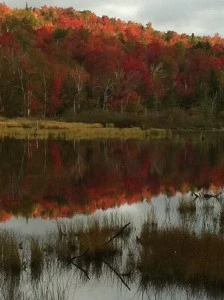 I am so excited about my upcoming vacation. If you recall last year we ventured to New England to hike in the White Mountains. This year we are staying closer to home and hiking in the north Georgia Mountains. Because we will be moving by foot, it will allow us to get an intimate look at the fall color change. Watching the transformation from green to brilliant hues, one has to contemplate how does autumn color happen? For years, scientists have worked to understand the changes that happen to trees and shrubs in the autumn. Every detail may not yet be revealed, but it is known that three factors influence autumn leaf color; leaf pigments, length of night, and weather. The timing of the color change and leaf fall is primarily regulated by the calendar, that is, the increasing length of night. As days grow shorter, and nights grow longer and cooler, biochemical processes in the leaf begin to paint the landscape with Nature’s autumn palette. A color palette needs pigments, and there are three types that are involved in autumn color.
I am so excited about my upcoming vacation. If you recall last year we ventured to New England to hike in the White Mountains. This year we are staying closer to home and hiking in the north Georgia Mountains. Because we will be moving by foot, it will allow us to get an intimate look at the fall color change. Watching the transformation from green to brilliant hues, one has to contemplate how does autumn color happen? For years, scientists have worked to understand the changes that happen to trees and shrubs in the autumn. Every detail may not yet be revealed, but it is known that three factors influence autumn leaf color; leaf pigments, length of night, and weather. The timing of the color change and leaf fall is primarily regulated by the calendar, that is, the increasing length of night. As days grow shorter, and nights grow longer and cooler, biochemical processes in the leaf begin to paint the landscape with Nature’s autumn palette. A color palette needs pigments, and there are three types that are involved in autumn color.
- Chlorophyll, which gives leaves their basic green color. It is necessary for photosynthesis, the chemical reaction that enables plants to use sunlight to manufacture sugars for their food. Trees in the temperate zones store these sugars for their winter dormant period.
- Carotenoids, which produce yellow, orange, and brown colors in such things as corn, carrots, and daffodils, as well as rutabagas, buttercups, and bananas.
- Anthocyanins, which give color to such familiar things as cranberries, red apples, concord grapes, blueberries, cherries, strawberries, and plums. They are water soluble and appear in the watery liquid of leaf cells.
Both chlorophyll and carotenoids are present in the chloroplasts of leaf cells throughout the growing season. Most anthocyanins are produced in the autumn, in response to bright light and excess plant sugars within leaf cells. During the growing season, chlorophyll is continually being produced and broken down and leaves appear green. As night length increases in the autumn, chlorophyll production slows down and then stops and eventually all the chlorophyll is destroyed. The carotenoids that are present in the leaf are then unmasked and show their colors. As leaves begin the process leading up to their fall, the veins that carry fluids into and out of the leaf gradually close off as a layer of cells forms at the base of each leaf. These clogged veins trap sugars in the leaf and promote the production of anthocyanins. Once this separation layer is complete and the connecting tissues are sealed off, the leaf is ready to fall.
Certain colors are characteristic of particular species. Oaks turn red, brown, or russet; hickories, golden bronze; aspen and yellow-poplar, golden yellow; dogwood, purplish red; beech, light tan; and sourwood and black tupelo, crimson. Maples differ species by species-red maple turns brilliant scarlet; sugar maple, orange-red; and black maple, glowing yellow. Leaves of some species such as the elms simply shrivel up and fall, exhibiting little color other than drab brown. The timing of the color change also varies by species, as best described by Sourwoods and Oaks. These differences in timing among species seem to be genetically inherited. The amount and brilliance of the colors that develop in any particular autumn season are related to weather conditions that occur before and during the time the chlorophyll in the leaves is dwindling. Temperature andmoisture are the main influences.



Comments (0)
Thanks for your comment!
Thanks for your feedback! Your comments have been successfully submitted! Please note, all comments require admin approval prior to display.
Error submitting comment!
There is a problem with your comment, please see below and try again.